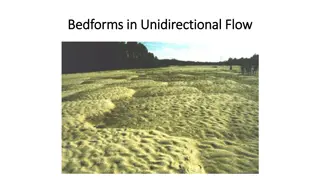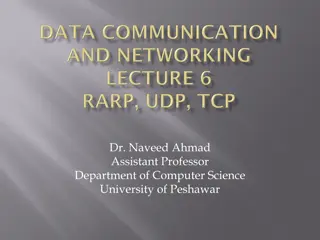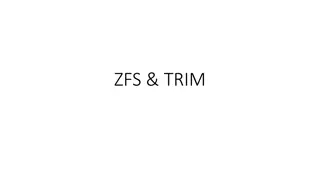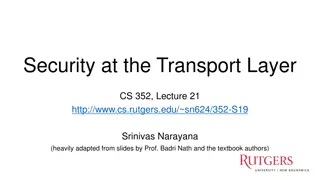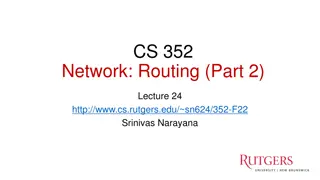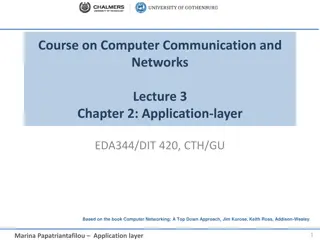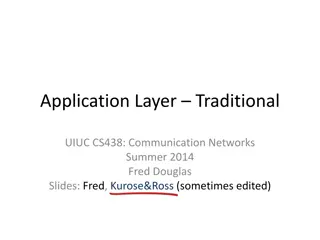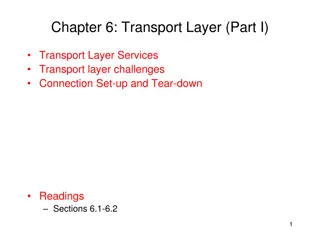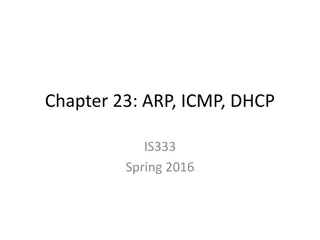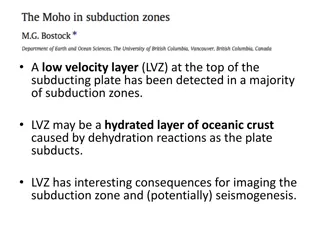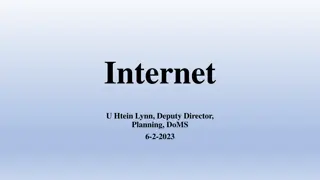Understanding Internet Transport Layer Services and Protocols
In the realm of networking, exploring the principles of transport layer services is crucial. This involves concepts like multiplexing/demultiplexing, reliable data transfer, flow control, and congestion control, which are facilitated by protocols such as UDP and TCP. The transport layer acts as a bridge between application processes on different hosts, ensuring effective communication through logical connections. TCP ensures reliable, in-order data delivery with congestion control, while UDP offers lightweight, unordered delivery. Dive into the world of transport layer protocols and their functionalities in the Internet landscape.
Download Presentation

Please find below an Image/Link to download the presentation.
The content on the website is provided AS IS for your information and personal use only. It may not be sold, licensed, or shared on other websites without obtaining consent from the author. Download presentation by click this link. If you encounter any issues during the download, it is possible that the publisher has removed the file from their server.
E N D
Presentation Transcript
Transport Layer Our goals: understand principles behind transport layer services: multiplexing/demultipl exing reliable data transfer flow control congestion control learn about transport layer protocols in the Internet: UDP: connectionless transport TCP: connection-oriented transport TCP congestion control Transport Layer 3-1
Transport services and protocols provide logical communication between app processes running on different hosts transport protocols run in end systems send side: breaks app messages into segments, passes to network layer rcv side: reassembles segments into messages, passes to app layer more than one transport protocol available to apps Internet: TCP and UDP application transport network data link physical network data link physical network data link physical network data link physical network data link physical network data link physical application transport network data link physical Transport Layer 3-2
Transport vs. network layer Household analogy: 12 kids sending letters to 12 kids processes = kids app messages = letters in envelopes hosts = houses transport protocol = Ann and Bill network-layer protocol = postal service network layer: logical communication between hosts transport layer: logical communication between processes relies on, enhances, network layer services Transport Layer 3-3
Internet transport-layer protocols reliable, in-order delivery (TCP) congestion control flow control connection setup unreliable, unordered delivery: UDP no-frills extension of best-effort IP services not available: delay guarantees bandwidth guarantees application transport network data link physical network data link physical network data link physical network data link physical network data link physical network data link physical application transport network data link physical Transport Layer 3-4
Multiplexing/demultiplexing Demultiplexing at rcv host: Multiplexing at send host: gathering data from multiple sockets, enveloping data with header (later used for demultiplexing) delivering received segments to correct socket = socket = process P4 application P1 P1 P2 P3 application application transport transport transport network network network link link link physical physical physical host 3 host 2 host 1 Transport Layer 3-5
How demultiplexing works host receives IP datagrams each datagram has source IP address, destination IP address each datagram carries 1 transport-layer segment each segment has source, destination port number ( well-known port numbers for specific applications) host uses IP addresses & port numbers to direct segment to appropriate socket 32 bits source port # dest port # other header fields application data (message) TCP/UDP segment format Transport Layer 3-6
Connectionless demultiplexing When host receives UDP segment: checks destination port number in segment directs UDP segment to socket with that port number IP datagrams with different source IP addresses and/or source port numbers directed to same socket Create sockets with port numbers: UDP socket identified by two-tuple: (dest IP address, dest port number) Transport Layer 3-7
Connection-oriented demux TCP socket identified by 4-tuple: source IP address source port number dest IP address dest port number recv host uses all four values to direct segment to appropriate socket Server host may support many simultaneous TCP sockets: each socket identified by its own 4-tuple Web servers have different sockets for each connecting client non-persistent HTTP will have different socket for each request Transport Layer 3-8
Figure 3.5 Transport Layer 3-9
UDP: User Datagram Protocol [RFC 768] no frills, bare bones Internet transport protocol best effort service, UDP segments may be: lost delivered out of order to app connectionless: no handshaking between UDP sender, receiver each UDP segment handled independently of others Why is there a UDP? no connection establishment (which can add delay) simple: no connection state at sender, receiver small segment header no congestion control: UDP can blast away as fast as desired Transport Layer 3-10
UDP: more often used for streaming multimedia apps loss tolerant rate sensitive other UDP uses DNS SNMP reliable transfer over UDP: add reliability at application layer application-specific error recovery! 32 bits source port # length dest port # checksum Length, in bytes of UDP segment, including header Application data (message) UDP segment format Transport Layer 3-11
UDP checksum Goal: detect errors (e.g., flipped bits) in transmitted segment Receiver: compute checksum of received segment check if computed checksum equals checksum field value: NO - error detected YES - no error detected. But maybe errors Sender: treat segment contents as sequence of 16-bit integers checksum: addition (1 s complement sum) of segment contents sender puts checksum value into UDP checksum field Transport Layer 3-12
TCP: Overview point-to-point: one sender, one receiver reliable, in-order byte steam: no message boundaries pipelined: TCP congestion and flow control set window size send & receive buffers full duplex data: bi-directional data flow in same connection MSS: maximum segment size connection-oriented: handshaking (exchange of control msgs) init s sender, receiver state before data exchange flow controlled: sender will not overwhelm receiver application writes data application reads data socket door socket door TCP TCP send buffer receive buffer segment Transport Layer 3-13
TCP segment structure 32 bits URG: urgent data (generally not used) counting by bytes of data (not segments!) source port # sequence number acknowledgement number S R P A U len used dest port # ACK: ACK # valid head not Receive window Urg data pnter F PSH: push data now (generally not used) # bytes rcvr willing to accept checksum RST, SYN, FIN: connection estab (setup, teardown commands) Options (variable length) application data (variable length) Internet checksum (as in UDP) Transport Layer 3-14
TCP seq. #s and ACKs Seq. # s: byte stream number of first byte in segment s data ACKs: seq # of next byte expected from other side cumulative ACK Q: how receiver handles out-of-order segments A: TCP spec doesn t say, - up to implementor Host B Host A User types C host ACKs receipt of C , echoes back C host ACKs receipt of echoed C time simple telnet scenario Transport Layer 3-15
TCP Round Trip Time and Timeout Q: how to estimate RTT? SampleRTT: measured time from segment transmission until ACK receipt ignore retransmissions SampleRTT will vary, want estimated RTT smoother average several recent measurements, not just current SampleRTT Q: how to set TCP timeout value? longer than RTT but RTT varies too short: premature timeout unnecessary retransmissions too long: slow reaction to segment loss Transport Layer 3-16
Example RTT estimation: RTT: gaia.cs.umass.edu to fantasia.eurecom.fr 350 300 250 RTT (milliseconds) 200 150 100 1 8 15 22 29 36 43 50 57 64 71 78 85 92 99 106 time (seconnds) SampleRTT Estimated RTT Transport Layer 3-17
TCP Round Trip Time and Timeout EstimatedRTT = (1- )*EstimatedRTT + *SampleRTT Exponential weighted moving average influence of past sample decreases exponentially fast typical value: = 0.125 Transport Layer 3-18
TCP Round Trip Time and Timeout Setting the timeout EstimtedRTTplus safety margin large variation in EstimatedRTT -> larger safety margin first estimate of how much SampleRTT deviates from EstimatedRTT: DevRTT = (1- )*DevRTT + *|SampleRTT-EstimatedRTT| (typically, = 0.25) Then set timeout interval: TimeoutInterval = EstimatedRTT + 4*DevRTT Transport Layer 3-19
TCP reliable data transfer TCP creates rdt service on top of IP s unreliable service Pipelined segments Cumulative acks TCP uses single retransmission timer Retransmissions are triggered by: timeout events duplicate acks Initially consider simplified TCP sender: ignore duplicate acks ignore flow control, congestion control Transport Layer 3-20
TCP sender events: data rcvd from app: Create segment with seq # seq # is byte-stream number of first data byte in segment start timer if not already running (think of timer as for oldest unacked segment) expiration interval: TimeOutInterval timeout: retransmit segment that caused timeout restart timer Ack rcvd: If acknowledges previously unacked segments update what is known to be acked start timer if there are outstanding segments Transport Layer 3-21
NextSeqNum = InitialSeqNum SendBase = InitialSeqNum TCP sender (simplified) loop (forever) { switch(event) event: data received from application above create TCP segment with sequence number NextSeqNum if (timer currently not running) start timer pass segment to IP NextSeqNum = NextSeqNum + length(data) Comment: SendBase-1: last cumulatively ack ed byte Example: SendBase-1 = 71; y= 73, so the rcvr wants 73+ ; y > SendBase, so that new data is acked event: timer timeout retransmit not-yet-acknowledged segment with smallest sequence number start timer event: ACK received, with ACK field value of y if (y > SendBase) { SendBase = y if (there are currently not-yet-acknowledged segments) start timer } } /* end of loop forever */ Transport Layer 3-22
TCP: retransmission scenarios Host A Host B Host A Host B Seq=92 timeout timeout X loss Sendbase = 100 Seq=92 timeout SendBase = 120 SendBase = 100 SendBase = 120 premature timeout time time lost ACK scenario Transport Layer 3-23
TCP retransmission scenarios (more) Host A Host B timeout X loss SendBase = 120 time Cumulative ACK scenario Transport Layer 3-24
TCP ACK generation TCP Receiver action Event at Receiver Delayed ACK. Wait up to 500ms for next segment. If no next segment, send ACK Arrival of in-order segment with expected seq #. All data up to expected seq # already ACKed Immediately send single cumulative ACK, ACKing both in-order segments Arrival of in-order segment with expected seq #. One other segment has ACK pending Immediately send duplicate ACK, indicating seq. # of next expected byte Arrival of out-of-order segment higher-than-expect seq. # . Gap detected Immediate send ACK, provided that segment starts at lower end of gap Arrival of segment that partially or completely fills gap Transport Layer 3-25
Fast Retransmit Time-out period often relatively long: long delay before resending lost packet Detect lost segments via duplicate ACKs. Sender often sends many segments back-to- back If segment is lost, there will likely be many duplicate ACKs. If sender receives 3 ACKs for the same data, it supposes that segment after ACKed data was lost: fast retransmit: resend segment before timer expires Draw fig. 3.37 on board Transport Layer 3-26
TCP Flow Control flow control sender won t overflow receiver s buffer by transmitting too much, too fast receive side of TCP connection has a receive buffer: speed-matching service: matching the send rate to the receiving app s drain rate app process may be slow at reading from buffer Transport Layer 3-27
TCP Flow control: how it works Rcvr advertises spare room by including value of RcvWindow in segments Sender limits unACKed data to RcvWindow guarantees receive buffer doesn t overflow (Suppose TCP receiver discards out-of-order segments) spare room in buffer = RcvWindow = RcvBuffer-[LastByteRcvd - LastByteRead] Transport Layer 3-28
TCP Connection Management Three way handshake: Recall: TCP sender, receiver establish connection before exchanging data segments initialize TCP variables: seq. #s buffers, flow control info (e.g. RcvWindow) client: connection initiator Socket opens server: contacted by client Socket welcomed Step 1:client host sends TCP SYN segment to server specifies initial seq # no data Step 2:server host receives SYN, replies with SYNACK segment server allocates buffers specifies server initial seq. # Step 3: client receives SYNACK, replies with ACK segment, which may contain data Transport Layer 3-29
TCP Connection Management (cont.) Closing a connection: client closes socket Step 1: client end system sends TCP FIN control segment to server Step 2: server receives FIN, replies with ACK. Closes connection, sends FIN. client server close close timed wait closed Transport Layer 3-30
TCP Connection Management (cont.) Step 3: client receives FIN, replies with ACK. client server closing Enters timed wait - will respond with ACK to received FINs closing Step 4: server, receives ACK. Connection closed. timed wait closed closed Transport Layer 3-31
TCP Connection Management (cont) TCP server lifecycle TCP client lifecycle Transport Layer 3-32
Principles of Congestion Control Congestion: informally: too many sources sending too much data too fast for networkto handle different from flow control! manifestations: lost packets (buffer overflow at routers) long delays (queueing in router buffers) a problem many researchers are working on Transport Layer 3-33
Causes/costs of congestion: scenario 1 Host A out two senders, two receivers one router, infinite buffers no retransmission in : original data unlimited shared output link buffers Host B large delays when congested maximum achievable throughput Transport Layer 3-34
Causes/costs of congestion: scenario 2 one router, finite buffers sender retransmission of lost packet Host A out in : original data 'in : original data, plus retransmitted data Host B finite shared output link buffers Transport Layer 3-35
Causes/costs of congestion: scenario 2 in out always: (goodput) perfect retransmission only when loss: retransmission of delayed (not lost) packet makes larger (than perfect case) for same = out in > in out costs of congestion: more work (retrans) for given goodput unneeded retransmissions: link carries multiple copies of pkt Transport Layer 3-36
Causes/costs of congestion: scenario 3 four senders multihop paths timeout/retransmit in Q:what happens as and increase ? in out Host A in : original data 'in : original data, plus retransmitted data finite shared output link buffers Host B Transport Layer 3-37
Causes/costs of congestion: scenario 3 o u t H o s t A H o s t B Another cost of congestion: when packet dropped, any upstream transmission capacity used for that packet was wasted! Transport Layer 3-38
Approaches towards congestion control Two broad approaches towards congestion control: Network-assisted congestion control: routers provide feedback to end systems single bit indicating congestion (special bits) explicit rate sender should send at End-end congestion control: no explicit feedback from network congestion inferred from end-system observed loss, delay approach taken by TCP Transport Layer 3-39
TCP Congestion Control How does sender perceive congestion? loss event = timeout or 3 duplicate acks TCP sender reduces rate (CongWin) after loss event three mechanisms: AIMD slow start conservative after timeout events end-end control (no network assistance) sender limits transmission: LastByteSent-LastByteAcked min{CongWin,RcvWindow} Roughly, CongWin rate = Bytes/sec RTT CongWin is dynamic, function of perceived network congestion Transport Layer 3-40
TCP AIMD additive increase: increase CongWin by 1 MSS every RTT in the absence of loss events: probing multiplicative decrease: cut CongWin in half after loss event congestion window 24 Kbytes 16 Kbytes 8 Kbytes time Long-lived TCP connection Transport Layer 3-41
TCP Slow Start When connection begins, increase rate exponentially fast until first loss event When connection begins, CongWin = 1 MSS Example: MSS = 500 bytes & RTT = 200 msec initial rate = 20 kbps available bandwidth may be >> MSS/RTT desirable to quickly ramp up to respectable rate Transport Layer 3-42
TCP Slow Start (more) When connection begins, increase rate exponentially until first loss event: double CongWin every RTT done by incrementing CongWin for every ACK received Summary: initial rate is slow but ramps up exponentially fast Host A Host B RTT time Transport Layer 3-43
Refinement Philosophy: After 3 dup ACKs: CongWin is cut in half window then grows linearly But after timeout event: CongWin instead set to 1 MSS; window then grows exponentially to a threshold, then grows linearly 3 dup ACKs indicates network capable of delivering some segments timeout before 3 dup ACKs is more alarming Transport Layer 3-44
Refinement (more) Q: When should the exponential increase switch to linear? A: When CongWin gets to 1/2 of its value before timeout. Implementation: Variable Threshold At loss event, Threshold is set to 1/2 of CongWin just before loss event Transport Layer 3-45
Summary: TCP Congestion Control When CongWin is below Threshold, sender in slow-start phase, window grows exponentially. When CongWin is above Threshold, sender is in congestion-avoidance phase, window grows linearly. When a triple duplicate ACK occurs, Threshold set to CongWin/2 and CongWin set to Threshold. When timeout occurs, Threshold set to CongWin/2 and CongWin is set to 1 MSS. Transport Layer 3-46
TCP Fairness Fairness goal: if K TCP sessions share same bottleneck link of bandwidth R, each should have average rate of R/K TCP connection 1 bottleneck router capacity R TCP connection 2 Transport Layer 3-47
Why is TCP fair? Two competing sessions: Additive increase gives slope of 1, as throughout increases multiplicative decrease decreases throughput equal bandwidth share R loss: decrease window by factor of 2 congestion avoidance: additive increase loss: decrease window by factor of 2 congestion avoidance: additive increase Connection 1 throughput R Transport Layer 3-48
Fairness (more) Fairness and parallel TCP connections nothing prevents app from opening parallel cnctions between 2 hosts. Web browsers do this Example: link of rate R supporting 9 cnctions; new app asks for 1 TCP, gets rate R/10 new app asks for 11 TCPs, gets R/2 ! Fairness and UDP Multimedia apps often do not use TCP do not want rate throttled by congestion control Instead use UDP: pump audio/video at constant rate, tolerate packet loss Research area: TCP friendly Transport Layer 3-49
Delay modeling Notation, assumptions: Assume one link between client and server of rate R S: MSS (bits) O: object size (bits) no retransmissions (no loss, no corruption) Window size: First assume: fixed congestion window, W segments Then dynamic window, modeling slow start Q: How long does it take to receive an object from a Web server after sending a request? Ignoring congestion, delay is influenced by: TCP connection establishment data transmission delay slow start Transport Layer 3-50










